Instructions to Candidates
- Write your name and index number in the spaces provided above.
- write the class and date of examination in the spaces provided above.
- This paper consists of 2 sections; A and B
- Answer all questions in section A in the spaces provided.
- In section B answer question 6(compulsory) and either question 7 or 8 in the spaces provided after question 8
- Candidates should check the question paper to ascertain that all the pages are printed as indicated and that no questions are missing.
- Candidates should answer all the questions in English.
QUESTIONS
SECTION A
-
- The following diagrams represent human sex cells.

- Name the cell B (1mk)
- Give one feature of cell A which makes it different from cell B. (1mk)
- The diagram below represents the female reproductive system
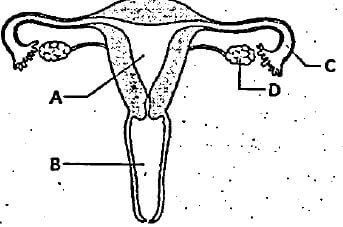
- Name the part marked A. (1mk)
- State the role of the part marked D. (1mk)
- State two functions of amniotic fluid. (2mks)
-
- Name the organism that causes syphilis. (1mk)
- State one symptom of primary syphilis. (1mk)
- The following diagrams represent human sex cells.
- The diagram below shows the structure of a chromosome.
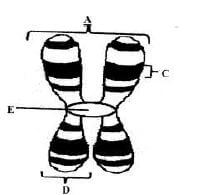
- Identify the parts labelled D and E. (2mks)
D
E - Name two organelles in an animal cell where DNA is found. (1mk)
-
- What is meant by the term linked genes? (1mk)
- Haemophilia is a genetic condition transmitted through a recessive gene linked to X chromosome. The normal gene may be represented by XH.
- A woman who is a carrier for the haemophilia gene marries a normal man. Work out the phenotypic ratio for their offspring. (4mks)
- Identify the parts labelled D and E. (2mks)
- The diagram below represents a food web in a terrestrial ecosystem.
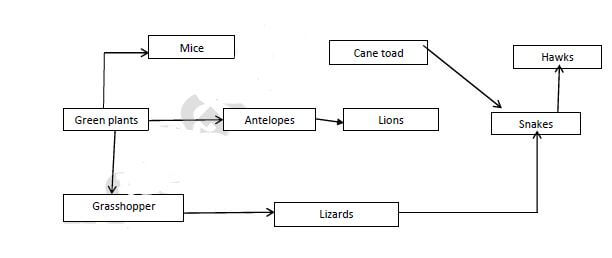
-
- Which organism has the least biomass? (1mrk)
- Give reasons for the answer given in a) (i) above. (2mks)
- Construct food chains with snakes as tertiary consumers. (2mks)
- State the trophic level occupied by hawks in the food chains constructed in (b) above (1mk)
- Name the process through which:
- Producers convert chemical energy into heat energy lost to the environment. (1mk)
- Living organisms convert chemical energy into heat energy lost to the environments. (1mk)
-
- Below is a chemical equation, study it and answer the questions that follow: -
Carbon(IV) oxide + water Oxygen + glucose
Oxygen + glucose- Name process A and B (2 Marks)
- What is the biological significance of process A? (1 mark)
- In which organelle does process A and B take place? (2 marks)
A
B - Name two stages of process B. (2 marks)
- Define compensation point. (1mark)
- The diagram below shows how blood sugar in mammalian body is regulated.
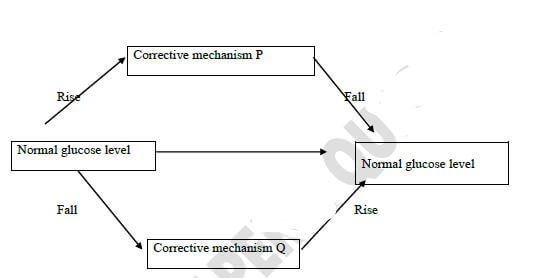
- Explain what happens during corrective mechanism P. (3mks)
- Name two organs involved in corrective mechanisms P and Q. (2mks)
- State the reasons why glucose level should be maintained constant. (2mks)
- What is osmoregulation? (1mk)
SECTION B (40 MARKS)
Answer question 6(compulsory) and either 6 or 7 in the spaces provided.
- Two sets of a pea seeds were germinated, set A was placed in normal day light conditions in the laboratory which set B was placed in a dark cupboard. Starting a few days later the shoots lengths were measured twice daily and their mean length recorded as shown in the table below.
Time in hours 0 12 24 36 48 60 72 84 Set A (length mm) 12 14 20 23 28 31 47 54 Set B length (mm) 17 23 28 35 48 62 80 94 - Using suitable scale draw the graphs of the mean lengths in set A and B against time (7mks)
- From the graph, state the man shoot length of each set of seedling at the 66th hour. (2mks)
- Account for the difference of curve B and A. (3mks)
- Explain what would happen to set up B if it were allowed to continue to grow under conditions of darkness. (4mks)
- State 3 external conditions which should be constant for both set ups. (3mks)
- Why is oxygen important in the process of active transport? (1mk)
-
- Define:
- Transpiration. (2mks)
- Translocation. (2mks)
- Identify and explain structural factors that affects the rate of transpiration in plants. (16mks)
- Define:
- Describe the adaptations of the mammalian eye to its function. (20 marks)
MARKING SCHEME
-
-
- Ovum
- Cell A has a tail unlike B
Cell A has mitochondrion sheath unlike cell B
Cell A is tadpole in shape while cell B is circular in shape.
-
- uterine cavity
- Site for ova formation
Secretion of oestrogen and progesterone
- Absorbs shock protecting the foetus from external mechanical damage
Provides fluid medium that suspends the foetus allowing it to move and grow freely -
- Treponema Pallidum
- painless ulcers on genitals or mucous membrane.
-
-
- D – Chromatid
E – Centromere -
- Nucleus and mitochondria; (both to be given to earn the mark)
-
- Genes located on the same chromosome and are transmitted together.
- Parental genotype XHXh X XHY;
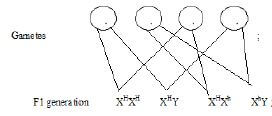
Phenotypic ratio 3 Normal: 1 Haemophiliac;
- D – Chromatid
-
-
- Hawk
- At each of the lower trophic level, some energy is lost as heat, during excretion , sweating.
Some of the food is used during respiration to produce energy.
Some of the parts of the organisms are not eaten.
Some energy is lost as undigested or indigested food materials.
- Green plants Grasshoppers’ lizards Snakes Hawks
Green plants mice’ cane toads Snakes Hawks - Quaternary consumers
-
- Photosynthesis
- Respiration
-
-
- A- Photosynthesis ;
B – Respiration - Provision of food to plants organisms when convert light energy into chemical energy to make their own food which is later consumed by animals;
- A – chloroplast ;
B – Mitochondrion ; - Glycolysis ; Kreb’scycle
- This is the point when the rate of photosynthesis is equal to the rate respiration / All the carbon dioxide released in respiration is used up by photosynthesis.
- A- Photosynthesis ;
-
- -Excess glucose is converted to glycogen and stored in the liver/ muscle cells.
-Excess glucose is oxidised to release energy
-Some glucose is converted into fats and stored in adipose tissue. - Pancreas and liver
- To avoid fluctuation in osmotic pressure which disrupt metabolism;
Enough glucose is required for normal functioning of the cells. - Maintenance of constant internal osmotic pressure.
OR
Maintenance of water and ion concentration in an organism at a constant state.
Question 6 graph.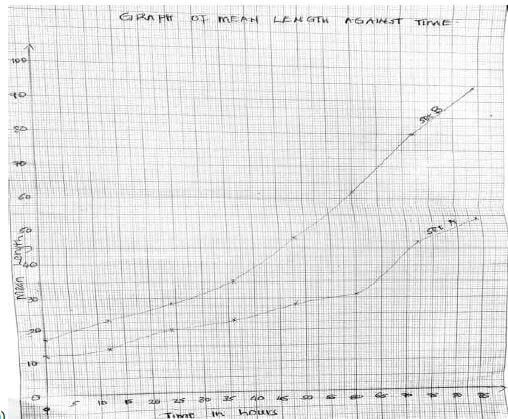
- -Excess glucose is converted to glycogen and stored in the liver/ muscle cells.
-
- Graph scale 2mks
Labeling axis1mk
Curves 2mk
Plotting 1mk
Curve Identity 1mk - A 37 ± 1
B 70 ± 1 - There is faster growth in B than A; this is to enable plant to obtain light energy for ;photosynthesis.
- The plant would become very weak, and finally die; the plant would exhaust all the food reserve in the cotyledon; since there is no photosynthesis due to lack of light
- Oxygen supply; amount of water; amount of soil nutrients; and temperature
- Oxygen is required for respiration; which produces energy necessary for the process to occur
- Graph scale 2mks
-
- Transpiration is the loss of water in form of water vapour; from a plant into the atmosphere through the stomata cuticle/lenticels. (2 mks)
Rej. If transpiration sites are not mentioned /loss of water alone instead of water vapour.
Translocation is the transportation of soluble organic products of photosynthesis within the plant; through the phloem tissue. (2 mks - Stomata; (number, distribution and structural features).The fewer the stomata the lower the rate of transpiration; (accept the converse)A leaf with fewer and narrower stomatal apertures and loose less water; compared to that numerous and wider stomatal apertures; Absence of stomata of the upper leaf surface minimize water loss from the plant. Sunken stomata below the epidermis; which form pits reduces rates of transpiration due to accumulation of water vapour in these pits; that reduces the diffusion gradient. Reverse stomata closure minimize water loss. Leaf sized and shape; Braod leaves provides a large surface area for transpiration to occur; hence high rate of water loss; Plants with small and sometimes needle like leaves have
low rate of transpiration since only small leaf surface area is exposed for transpiration; Leaf fall; Deciduous plants shed off their broad leaves during drought periods; to reduce the total leaf surface area exposed for transpiration.
Cuticle is a semi-transparent waxy and water-proof material found on the surface of leaves .Leaves of plants in dry habitat have a thick layer of cuticle; (to conserve water) by reducing rate of transpiration. Plants growing in wet areas have their layer of cuticle; to allow high rate of transpiration; (hence get rid of excess water).
(Total 21 marks, max -16 marks)
- Transpiration is the loss of water in form of water vapour; from a plant into the atmosphere through the stomata cuticle/lenticels. (2 mks)
- Sclera/sclerotic layer; white fibrous layer; made up of thick connective tissue; protects the eye; maintains shape of eyeball. Cornea; transparent; disc-shaped layer; that allows light to enter the eye; refracts light towards the retina. Conjunctiva; delicate membrane; lining the inside of the eyelid; protects the cornea/eye. Eyelids and eye lashes; thin muscle with hairs; protects the cornea/eye from mechanical/chemical damage/protects the eye from entry of foreign Particles; protects retina from bright light. Choroid; dark pigmented and membranous layer; that prevents light reflection within the eye/absorbs light; to prevent distortion of the image; has blood vessels; that nourish eye/retina/supply oxygen/remove carbon (IV) oxide and wastes; extends to form the ciliary
body and iris. Ciliary muscles; have elastic muscles that contract and relax; to alter shape/curvature of lens during accommodation; Ciliary body; thickened front edge of the choroids layer; that produces aqueous humour; Suspensory ligaments; made up of elastic connective tissue whose contraction and relaxation helps to adjust the shape of lens during accommodation/holds lens in position; Lens; transparent; biconvex; balloon-like; it refracts light rays/focus light onto the retina. Vitreous humour; nourishes cornea/lens; refraction of light; maintains eyeball shape; Iris; thin circular ring; with circular and radial muscles; it gives eye colour/absorbs light; controls the amount of light entering the eye/adjusts size of pupil. Pupil; an aperture through which light
enters the eye; Retina; has photoreceptor cells/rods/cones for image formation; generates impulses to the brain for interpretation. Fovea centralis; with only cones; for high visual acuity/most sensitive part of the retina Blind spot; point where nerve fibres emerge from the optic nerve/where optic nerve leaves eye/point where nerve fibres and blood vessels enter the eye. Optic nerve; transmits impulses to the brain; Muscles; inferior and superior oblique muscles; move eye from left to right; superior and inferior rectus muscles; move the eye up and down; external and internal rectus muscles steady the eye in its up and down movement. Tear/Lachrymal glands; secrete a watery and saline fluid containing lysozymes/lytic enzymes/is antiseptic (tears); that moisten the conjunctiva and cornea; washes away dust and other foreign objects; kills microorganisms entering the eye;
( Max. 20 mks)
Download Biology Paper 2 Questions and Answers - Lanjet Joint Mock Exams 2022.
Tap Here to Download for 50/-
Get on WhatsApp for 50/-
Why download?
- ✔ To read offline at any time.
- ✔ To Print at your convenience
- ✔ Share Easily with Friends / Students
